![]()
![]()
![]()
Use LEFT and RIGHT arrow keys to navigate between flashcards;
Use UP and DOWN arrow keys to flip the card;
H to show hint;
A reads text to speech;
134 Cards in this Set
- Front
- Back
|
pre history |
period of human existence before the availability of written records |
|
|
Lith / flint |
It means stone |
|
|
preliterate |
not yet employing writing as a cultural medium |
|
|
carbon-dating - or radiocarbon dating |
is a method that provides objective age estimates for carbon-based materials that originated from living organisms. |
|
|
material culture |
refer to corporeal, tangible objects that are created, used, kept and left behind by past and present cultures |
|
|
artifact |
an object, such as a tool, that was made in the past |
|
|
Stone Age |
considered the preliterate period, covering at least 95% of man's existence and did not end until about 5000 BC. |
|
|
Paleolithic, Mesolithic, Neolithic |
stone age is divided into what three periods? |
|
|
metal age |
A period wherein human history is based upon written records or a history of civilized nations. |
|
|
Copper, Bronze, Iron |
Metal age is divided into what 3 principal ages? |
|
|
Old |
paleo means ? |
|
|
Stone |
lithos means ? |
|
|
Lower Paleolithic |
the longer period covering 75% of the Old Stone Age |
|
|
Zinjanthropus boisei |
was found in Tanganyika, Central Africa; he walked erect |
|
|
Pithecanthropus erectus, a.k.a. Java Man |
the oldest man-like creature was discovered in Java, Indonesia in 1891 |
|
|
Sinanthropus pekinensis, aka Peking Man |
- discovered in 1929–37 during excavations at Zhoukoudian near Beijing, China |
|
|
Fontechevade Man |
-- found in 1947 in Charente, SW France |
|
|
Homo Neanderthalensis - |
discovered in Neander Valley, near Dusseldorf, NW Germany in 1856 |
|
|
Neanderthal man |
These group of people left evidences of improved methods of stone chipping by using only the flakes |
|
|
hearths |
Means (fireplace) |
|
|
Cro-Magnon |
certain group of people that was discovered in the Cro-Magnon cave in Dordogne, France |
|
|
Middle |
meso means ? |
|
|
Mesolithic period |
Scholars recognize this period as a transition from hunting-gathering to primitive agriculture. |
|
|
Mesolithic period |
This was also the beginning of the domestication of animals |
|
|
Microliths |
(very small stone tools) |
|
|
New |
Neo in Neolothic means ? |
|
|
Neolothic Period |
This is the period when stone weapons and tools were made by grinding and polishing instead of chipping. |
|
|
Neolithic Period |
in this period, Pottery was invented to preserve and store their food supply. |
|
|
Stone borers |

The picture above is called as ______. |
|
|
Monogamous |
involving marriage to one person at a time. |
|
|
False |
TRUE/FALSE? When a man is married to more than one wife at the same time, sociologists call this polyandry . When a woman is married to more than one husband at a time, it is called polygyny. |
|
|
D |
Neolithic period is also credited for the following, except one. A.Invention of the calendar to guide people when to plant and harvest crops. B.Discovery of metal tools like bronze and then iron initially for agricultural use. C.Development of irrigation systems D.Improved hunting and gathering practices allowed for an increase in leatherwork and basketry. Baskets were used to trap fish in streams. |
|
|
Copper |
Khalkos means ______? |
|
|
Copper Age |
This period therefore, is an archaeological period considered as the transition between the Neolithic and the Bronze Age |
|
|
Bronze age |
The invention of the wheel, the first writing systems were the notable accomplishments of this period. |
|
|
Iron Age. |
This is an archaeological period when ferrous metallurgy was the dominant technology. |
|
|
mudbrick or mud-brick |
- an air-dried brick, made of a mixture of loam, mud, sand and water mixed with a binding material such as rice husks or straw. |
|
|
bitumen - |
an asphalt of Asia Minor used in ancient times as a cement and mortar. |
|
|
mastic |
- a waterproof filler and sealant used in building (wiki) |
|
|
Meteoric iron |
is a metallic state that required no smelting of ores, a pre-Iron Age technology. |
|
|
polychrome |
- the practice of decorating architectural elements, sculpture, etc., in a variety of colors. The term is used to refer to certain styles of architecture, pottery or sculpture in multiple colors. |
|
|
historiographical |
- the body of literature dealing with historical matters; histories collectively. |
|
|
sun-dried bricks. |
Plentiful supply of soil which, mixed w/ water into mud, produced what? |
|
|
Holocene Period |
This is also termed as the 'Age of Man' because man became the master of his environment. |
|
|
polytheistic - |
belief that there is more than 1 god |
|
|
Natufian |
Early people established settlements in the fertile areas of the Levant, where wild plants and animals flourished. British archaeologist Dorothy Garrod called these sites what? |
|
|
Cayonu |
was one of the earliest villages in the Near East to try metallurgy. |
|
|
communal |
for common use of the community |
|
|
pit house |
- a house that is semi-underground, usually built of stone and roofed with thatch. |
|
|
Anatolia |
From the Greek word anatole meaning rising, the place where the rising of the sun takes place. |
|
|
Catalhoyuk |
One of the first Neolithic villages discovered in the region, located in the Konya basin on the Central Anatolian Plateau. |
|
|
vassal |
under the protection of a feudal lord to whom he has vowed homage and fealty : a feudal tenant |
|
|
River |
Potamos is a Greek word for |
|
|
Babylonia |
The southern Mesopotamia is often called as ____? |
|
|
Code of Hammurabi |
It was a compilation of 282 rules carved from a 4-ton black stone diorite |
|
|
Assyria |
grew from a small Mesopotamian city-state to become the world's first military power. |
|
|
architectural typology |
a classification of characteristics found in buildings |
|
|
Hut |
is a primitive dwelling, the first man-made structure using various local materials such as wood, stone, grass, branches or earth. |
|
|
Stone hut |
- Foundations made of stone sunk beneath the floor, walls were usually of drystone or packed clay and the roof was made of thatch. |
|
|
Rubble |
Means Unncut, unpolished stones |
|
|
Mud hut (beehive hut) |
- (from 2,000 BC) made entirely of mud or clay bricks to cool the interior during intensely hot climate. |
|
|
Pit Houses |
Houses with floors that are lower than the ground level (semi-subterranean) to provide shelter from extreme weather conditions. |
|
|
Wood and grass hut |
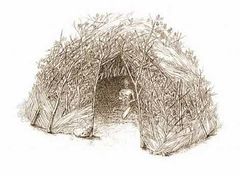
The picture above is considered as what type of hut? |
|
|
Beehive hut or mud hut |
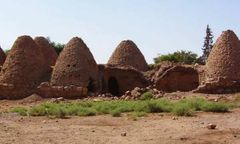
The picture above is an example of what type of hut? |
|
|
Stone hut |
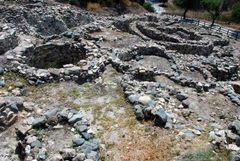
Picture above shows what type of hut? |
|
|
Pit house |
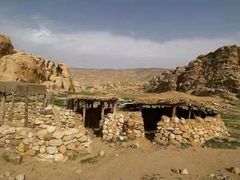
What do you call to the picture shown above? |
|
|
tell |
It is an artificial mound from an accumulation of mudbrick remains and other refuse, usually associated with the Near East. It is comprised of more than 2 houses. |
|
|
Jericho or Tell es-Sultan, Jordan (ca. 10,000 - 9,000 BC) |
- recognized by UNESCO as the oldest town in the world. |
|
|
Catalhoyuk |
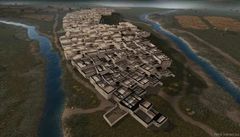
It was a big settlement with complex urban structures located in the moist climate of the Konya basin |
|
|
Corbel, corbelling |
- arch-like construction to span a space or void in a structure, such as an entranceway in a wall or as the roof of a tholos. |
|
|
palace |
is the official residence of a ruler. |
|
|
True |
True/false? The ruler's importance can be seen in the size of the throne room, and his economic power can be equated with the size and number of his storerooms. |
|
|
shrine |
is a dedicated place for an important or holy person of a society. |
|
|
temple |
is a sacred place associated to a religion. It is the accepted house of god/s. t is where people go to do the rituals of their religion. |
|
|
Gobekli Tepe (12,000 bp) |
- Discovered in 1994, it is recognized as the world's 'first temple' and believed to be older than the development of pottery, metalworking and other megalithic sites. |
|
|
stelae (pillars; stele if singular) |
Stelae means what? |
|
|
ziggurat |
is a platform with 4 sloping sides, like a stepped pyramid. |
|
|
revetment |
(stone facing) |
|
|
bent axis |
(90 degrees to face the altar) |
|
|
keyhole plan |
The long anteroom and tholos chamber is also known as the ___. |
|
|
tomb |
is a repository for the remains of the dead |
|
|
megalithic tomb |
with a large flat stone laid on upright ones (wiki). This (giant stone) structure is composed of 2 or more uprights supporting a horizontal stone table, usually for single-chamber tombs. |
|
|
cairns |
A pile of small stones |
|
|
Tumulus |
Mound placed over a grave |
|
|
Barrow |
Earth mound |
|
|
cist |
is a small stone-built coffin-like box or ossuary used to hold the bodies of the dead. |
|
|
ossuary |
- a container or room in which the bones of dead people are placed (wiki) |
|
|
thatch |
It is made of dried leaves |
|
|
peninsula |
land that is almost entirely surrounded by water) |
|
|
taiga |
a coniferous forest |
|
|
fjords |
a narrow inlet of the sea between cliffs or steep slopes |
|
|
loess |
- a loamy deposit formed by wind, usually yellowish and calcareous, common in the Mississippi Valley and in Europe and Asia (dictionary.com) |
|
|
gynecocentric |
(centered on women) |
|
|
regeneration |
In tomb-shrines, a winding snake figure is a symbol of what? |
|
|
The sorrowful ancient |
is depicted as a sitting man with hands on knees or supporting his face, usually appearing beside the seated pregnant figurines. |
|
|
Ganditorul or 'The Thinker of Cernavodar" |
is a terracotta sculpture that was excavated in 1953 in Romania and believed to be from circa 5000 BCE. |
|
|
aniconic |
symbolic rather than literally representational or not designed as a likeness |
|
|
silex |
(a silica, especially quartz or flint) |
|
|
protohistory |
a branch of study concerned with the transition period between prehistory and the earliest recorded history (dictionary.com) |
|
|
lean-to |
A shed erected against 1 wall of the cave |
|
|
Lascaux Cave, France |
- located in southwestern France, its occupation is evidenced by paintings within the cave. Images of people and animals were on the walls as a way to record their daily lives. |
|
|
Hut |
round or oval in plan made of stakes (wooden posts with pointed end driven into the ground) and built along the shore. The flooring was a thick bed of organic matter and ash, with pebble-lined or shallow pit central hearth. |
|
|
Terra Amata (Nice, France) |
- Central posts carry tree branches in A-frame position and are held in place on the ground with stones. There is a central hearth and an opening on the roof for venting smoke. |
|
|
mammoth bone hut |
(circular dump of bones with tools at the center) |
|
|
Tent |
common in glaciated parts of Old Europe. Early man survived the harsh climates in simple animal-hide tents located near a cave mouth or under a rock-overhang or in open air. |
|
|
teepee |
(portable conical tent made of animal skins) |
|
|
slate |
(gray or green metamorphic rock easily spslit into flat pieces) |
|
|
Pit house |
- semi-underground houses that are thermally efficient, common where climate was severe. The house may be oval or trapezoidal in plan with central post holes for the roof. |
|
|
Timber-framed house |
- a house made of big pieces of wood |
|
|
Wattle |
framework of twigs and branches; |
|
|
Daub |
To plaster with mud |
|
|
Longhouse - |
The Neolithic long house type was traced back in 5000 BCE to 7000 years ago. The first farmers who lived in western and central Europe introduced this longhouse type. The house was occupied by the extended families. |
|
|
turf |
(a patch of ground) |
|
|
stave wall |
- a wall formed by setting wooden planks vertically between a lower sill and an upper wall plate. |
|
|
trilithon |
(composed of 2 upright stones supporting a lintel stone) |
|
|
pronaos |
When the antae (anta if singular) or side walls are extended forward, an additional space is created which is like a front porch. It is called a ___. |
|
|
cella or naos |
main room is called ___ which contained the statue of the god. |
|
|
Abacus |
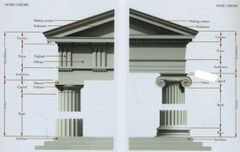
A. |
|
|
Dentils |
, a series of small square blocks. |
|
|
Shaft tombs |
Small holes were cut into stone to fit bodies in shafts, which were arranged in a large circular graveyard. The graves were marked by a stele and remains were buried with their material possessions. It is believed that this type of burial was reserved for rulers and nobility judging from the artifacts discovered on site. |
|
|
frieze |
is composed of several stacks of wood laid horizontally behind a vertical facing |
|
|
Thesauros/Treasuries |
These structures were built to store offerings to gods. |
|
|
The Temple of Hera (a.k.a. The Heraion) |
oldest Doric temple in Greece. |
|
|
citadel |
is the core fortified area of a town or city. It may be a castle, fortress, or fortified center. The term is a diminutive of "city" and thus means "little city", so called because it is a smaller part of the city of which it is the defensive core. |
|
|
Chamber tomb |
This is the most common tomb type, cut into the hills and accessible through a dromos leading down into earth or bedrock, stomion and thalamos |
|
|
Monumental tomb |
--a tomb for royalty or head of state |
|
|
stomion & thalamos |
(entrance to the tomb chamber) and (tomb chamber) |
|
|
House tomb |
As the name indicates, the house for the dead, common in the northern and eastern parts of Crete. This is a rectangular tomb that resembles a Minoan house containing various square rooms. The concept of life-after-death is seriously taken in this tomb, the biggest of which measures 39m x 30m. |
|
|
Collective tombs |
- tomb for one family or the whole community |
|
|
cist tomb |
is a small coffin-like box made of stone used to hold the bodies of the dead |
|
|
Individual tomb |
- Interment for one person |
|
|
Hellenistic Period (ca. 323 - 31 BC) - |
from the Greek word Hellazein, meaning "to speak Greek or identify with the Greeks." This period begins with the death of Alexander and ends with the Roman conquest |
|
|
Fresco (plural frescos or frescoes) |
is a technique of mural painting executed upon freshly laid ("wet") lime plaster. |
|
|
fortification |
(a defensive wall or other reinforcement built to strengthen a place against attack) |

